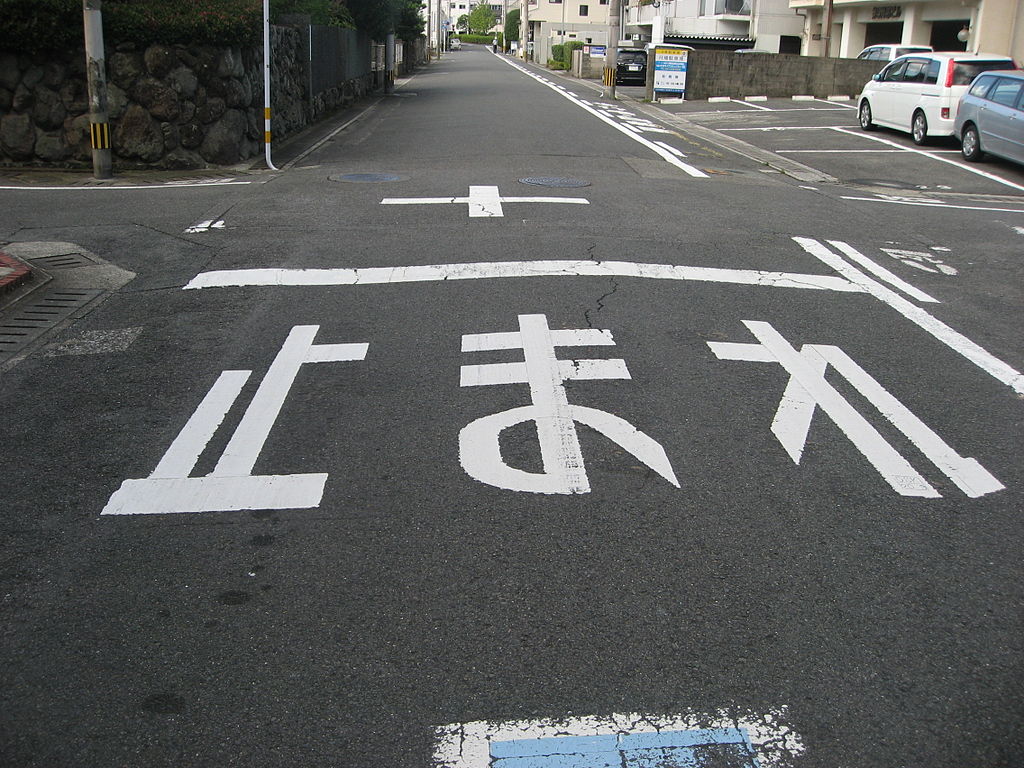Learning Japanese can be both exciting and challenging, especially when you're diving into essential words like "stop." Whether you're traveling to Japan or simply expanding your language skills, mastering how to say stop in Japanese is crucial. This word is not only useful in daily conversations but also vital in emergency situations. So, let's get started and explore the fascinating world of Japanese linguistics together!
Japanese is one of those languages that feels like a puzzle waiting to be solved. You might already know words like konnichiwa or arigatou, but today we're focusing on a word that could save the day – stop. Imagine being in Tokyo and needing to ask someone to stop, or perhaps signaling a bus to halt. Knowing this word will give you that extra confidence while navigating through the bustling streets.
And hey, don't worry if you're a complete beginner. This article is designed to make your learning experience smooth and enjoyable. Stick around, and by the end of it, you'll not only know how to say stop in Japanese but also understand the nuances that come with it. Let's dive right in!
Read also:How Tall Is Kendall Jenner In Cm Unveiling The Height Of A Global Icon
Understanding the Basics of Japanese Language
Before we jump into the specifics of how to say stop in Japanese, let's take a quick peek at the basics. Japanese has three writing systems: Hiragana, Katakana, and Kanji. Don't freak out if it sounds complicated at first. Hiragana and Katakana are phonetic scripts, meaning each character represents a sound, whereas Kanji uses characters with meanings.
Now, when it comes to expressing "stop," the Japanese language offers a few variations depending on the context. The most common way to say stop in Japanese is "tomare" (とまれ). This is a verb in its imperative form, which means it's a direct command. So, if you're in a situation where you need someone to stop immediately, this is your go-to phrase.
Breaking Down Tomare
Tomare comes from the verb "tomaru" (止まる), which means "to stop" or "to halt." In Japanese, verbs often change form based on politeness levels and context. The imperative form "tomare" is quite strong, so it's best used in situations where urgency is needed.
For example, if you're crossing the street and a car is coming too fast, shouting "tomare" will let the driver know they need to stop immediately. It's straightforward and gets the job done. However, if you're in a more formal setting, you might want to use a softer approach.
Polite Ways to Say Stop in Japanese
Japanese culture places a high value on politeness, and this is reflected in its language. If you're asking someone to stop in a polite manner, you can use "tomeru" (止める) instead of "tomare." Tomeru is the dictionary form of the verb and can be conjugated to fit different politeness levels.
Here’s a quick breakdown:
Read also:Edelman Wife The Intriguing Story Behind The Woman By His Side
- Tomeru: The basic form, used in neutral situations.
- Tomeru kudasai: A polite request, meaning "Please stop."
- Tomeru hou ga ii desu: A gentle suggestion, meaning "It would be better to stop."
Each variation serves a different purpose, so choosing the right one depends on the context and your relationship with the person you're addressing.
When to Use Polite Forms
Let's say you're in a business meeting and someone is speaking over you. Instead of shouting "tomare," which might come off as rude, you can politely say "tomeru kudasai" to ask them to stop. This approach shows respect while still getting your point across.
Or imagine you're teaching a class and a student is talking too loudly. You can gently suggest "tomeru hou ga ii desu" to encourage them to quiet down without causing embarrassment. These polite forms are essential for maintaining harmony in Japanese society.
Exploring Contextual Usage
Language is all about context, and Japanese is no exception. The way you say stop can vary depending on the situation. For instance, if you're talking about stopping an action, you might use a different word than if you're referring to stopping a vehicle.
Here are some common scenarios and the appropriate words to use:
- Stopping a vehicle: Use "tomare" for urgency or "tomeru kudasai" for politeness.
- Stopping an action: Use "yameru" (やめる), which means "to quit" or "to stop doing something."
- Stopping a sound: Use "shizuka ni shite kudasai" (静かにしてください), meaning "Please be quiet."
As you can see, the Japanese language offers a wide range of options to express the idea of stopping. Understanding these nuances will help you communicate more effectively in various situations.
Common Mistakes to Avoid
One common mistake learners make is using the wrong word in the wrong context. For example, saying "tomare" in a formal setting might come off as rude. Always consider the environment and the people you're speaking to before choosing your words.
Another mistake is overusing polite forms in casual conversations. While politeness is important, being too formal with friends or family can make you seem distant. Strike a balance by adjusting your language based on the relationship you have with the person.
Practical Tips for Mastering Stop in Japanese
Now that you know the different ways to say stop in Japanese, here are some practical tips to help you master this essential word:
- Practice pronunciation regularly. Japanese has specific sounds that might be unfamiliar to English speakers, so listening to native speakers can be incredibly helpful.
- Use flashcards or language apps to reinforce your learning. Repetition is key when it comes to memorizing new vocabulary.
- Engage in conversations with native speakers whenever possible. This will give you real-life experience and help you understand how the word is used in different contexts.
Remember, learning a language is a journey, and every step you take brings you closer to fluency. Don't be afraid to make mistakes – they're part of the process!
Resources for Further Learning
If you're eager to deepen your understanding of Japanese, there are plenty of resources available. Websites like NHK World and textbooks like "Genki" offer comprehensive lessons on grammar, vocabulary, and culture. Additionally, language exchange platforms can connect you with native speakers who are eager to help.
And let's not forget about YouTube! There are countless channels dedicated to teaching Japanese, from beginner lessons to advanced grammar. Watching videos in Japanese can improve your listening skills and expose you to natural speech patterns.
Cultural Insights: The Importance of Stopping
In Japanese culture, the concept of stopping goes beyond just halting an action or vehicle. It also represents mindfulness and reflection. For instance, the practice of "ma" (間) emphasizes the importance of pauses and empty spaces in art, music, and conversation. This philosophy encourages people to take a moment to appreciate the present and consider their next move.
So, when you say "stop" in Japanese, you're not just issuing a command – you're embracing a cultural value that emphasizes thoughtfulness and balance. Understanding this deeper meaning can enrich your language learning experience and help you connect with Japanese culture on a more profound level.
Modern Applications of Stop in Japanese
In today's fast-paced world, the word "stop" is more relevant than ever. Whether it's stopping to take a breath during a stressful day or halting an action that could harm others, the ability to pause and reflect is crucial. Japanese society recognizes this and incorporates it into daily life through practices like mindfulness and meditation.
For language learners, understanding the cultural significance of stop can enhance your communication skills and make you a more empathetic speaker. It's not just about knowing the word – it's about understanding its role in shaping relationships and interactions.
Conclusion: Take Your First Step Towards Mastery
Learning how to say stop in Japanese is more than just memorizing a word – it's about understanding the culture and context behind it. From the imperative "tomare" to the polite "tomeru kudasai," each variation offers a unique way to express yourself in Japanese. By mastering these words and their nuances, you'll be well on your way to becoming a confident and fluent speaker.
So, what are you waiting for? Dive into the world of Japanese language and culture, and don't forget to practice regularly. Share your experiences with fellow learners and continue exploring new vocabulary. Remember, every step you take brings you closer to fluency, so keep pushing forward!
Call to Action
Did you find this article helpful? Let us know in the comments below! If you have any questions or tips for fellow learners, feel free to share them. And don't forget to check out our other articles on Japanese language and culture. Together, we can make learning fun and accessible for everyone!
Until next time, keep practicing and stay curious!
Table of Contents
- Understanding the Basics of Japanese Language
- Breaking Down Tomare
- Polite Ways to Say Stop in Japanese
- Exploring Contextual Usage
- Common Mistakes to Avoid
- Practical Tips for Mastering Stop in Japanese
- Resources for Further Learning
- Cultural Insights: The Importance of Stopping
- Modern Applications of Stop in Japanese
- Conclusion: Take Your First Step Towards Mastery


